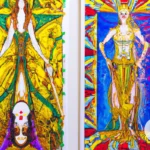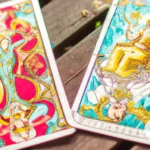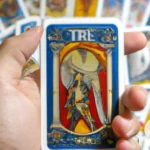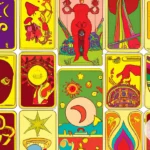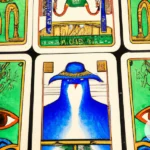The Rider-Waite Tarot Deck is undoubtedly one of the most popular and recognizable tarot decks in the Western world, but have you ever wondered about its origins and evolution? How did the tarot come to be, and how did it develop throughout the centuries? How did a talented illustrator and an enigmatic mystic come together to create such an iconic deck? And what makes the Rider-Waite Tarot Deck so rich in symbolism and meaning? In this article, we will delve into the fascinating history and evolution of the Rider-Waite Tarot Deck, exploring its origins, creators, symbolism, and legacy. Join us on a journey through the mysteries of the tarot!
The Beginnings of Tarot
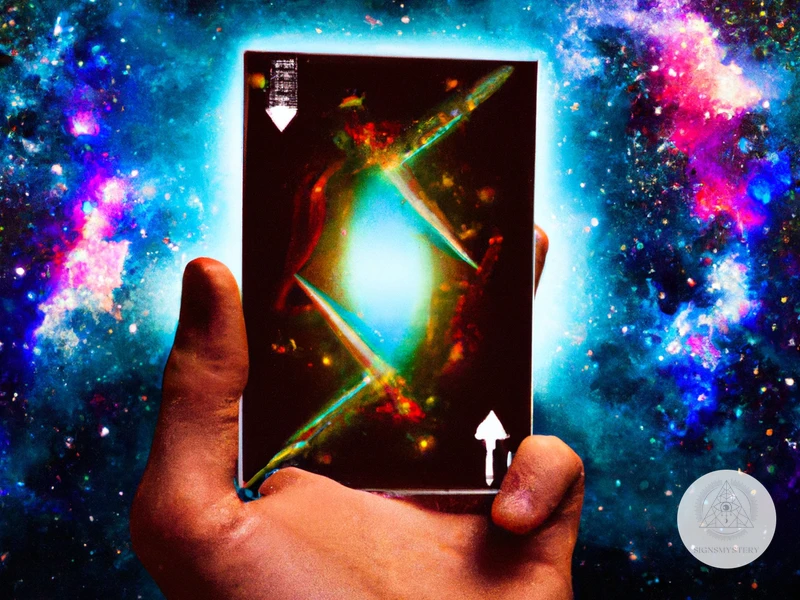
As we explore the origins of tarot, it is hard not to feel a sense of intrigue and mystery. The history of tarot is shrouded in myth and legend, with many stories and claims about its true origins. Some say that tarot was used by ancient Egyptian priests, while others argue that it was brought over to Europe by traveling Roma communities. Regardless of its true origins, it is widely accepted that the tarot originated in Italy during the 15th century, where it was primarily used for playing card games before evolving into the divinatory tool that we know today. To delve deeper into the history of tarot, we can trace its evolution from its beginnings in Italy all the way to the creation of the Rider-Waite Tarot Deck.
To explore more tarot decks, check out 10 Tarot Decks to Know, The Thoth Tarot Deck, or The Marseille Tarot Deck.
The Birth of Tarot
During the 14th century, tarot cards emerged in Europe as a new form of divination. The origin and purpose of these cards are still subjects of speculation and debate among historians and scholars. Some claim that tarot had roots in ancient Egypt or China, while others believe that it was a product of medieval Italy. However, there is little solid evidence to support either theory.
One theory is that the tarot was originally created for the Italian nobility to play a new type of card game. The Visconti-Sforza deck, which is now housed in the Pierpont Morgan Library in New York City, is one of the oldest surviving examples of early tarot cards. It was likely commissioned by the powerful Visconti family of Milan in the mid-15th century. This deck features the usual suits of swords, cups, coins, and batons, as well as 16 trump cards, which were later called the Major Arcana.
The images on the Major Arcana cards are rich in symbolism and steeped in religious and mystical traditions. They depict archetypal figures such as the High Priestess, the Emperor, the Hanged Man, and Death. Some historians believe that these figures represented various aspects of medieval society and culture, and that the cards were used to teach moral and ethical lessons.
Despite their noble origins, tarot cards gradually gained a reputation for divination and fortune-telling. By the 18th century, tarot decks were used by occultists and mystics as a tool for spiritual guidance and insight. This era saw the proliferation of various decks, each with their own unique interpretations of the tarot symbolism. Some of these decks, such as the Tarot de Marseille, became enduring classics that still influence modern tarot deck designs today.
Among the most famous and influential of these modern designs is the Rider-Waite Tarot Deck, created by the occultist Arthur Edward Waite and illustrated by Pamela Colman-Smith. This deck, first published in 1909, has become the standard by which all other tarot decks are measured. It has inspired countless imitations and reinterpretations, from the magical Illuminati Tarot Symbolism to the whimsical Faeries Oracle Deck, each with their own style and flavor.
From Italy to France
Tarot was played primarily as a game in Italy until the late 1700s when it found its way to France. It was in France where tarot began its transformation into a tool for divination and fortune-telling. The French occultists saw the potential for tarot to reveal mystical and spiritual truths, and they began to incorporate it into their esoteric practices.
Etteilla, a French Freemason and occultist, was the first to publish a tarot deck specifically designed for divination in 1789. He believed that tarot held secrets from ancient Egypt and incorporated Egyptian motifs into his deck. His deck, the Etteilla Tarot, was innovative in that it featured correspondences between the tarot, astrology, and the Kabbalah. His approach to tarot influenced the designs of later tarot decks, including the Rider-Waite Tarot.
Another influential French tarot designer was Eliphas Levi, a French occult author and teacher who published “The Doctrine and Ritual of High Magic” in 1855. In his book, he wrote extensively about tarot’s symbolism and its use as a tool for spiritual development. Levi believed that tarot held the key to understanding the mysteries of the universe and the human psyche. His writings on tarot inspired many occultists who followed, including Arthur Edward Waite.
In the late 1800s and early 1900s, tarot continued to gain popularity in France, and tarot decks were being designed with more elaborate and intricate artwork. Some of the most notable decks from this time include the Illuminati Tarot, the Mythical Creatures Tarot, and the Nature Druid Tarot. These decks all feature intricate, detailed illustrations that draw heavily on mystical and esoteric symbolism.
The French occultists of the 18th and 19th centuries played an essential role in the development of tarot as a tool for divination and spiritual exploration, and their ideas and designs continue to influence tarot design to this day.
The Tarot de Marseille
The Tarot de Marseille is one of the most well-known and influential tarot decks in history. With its origins in Italy, it eventually made its way to France, where it was popularized and became the standard for many tarot decks to follow.
History: The origins of the Tarot de Marseille can be traced back to the 15th century when card games were becoming increasingly popular in Italy. These games involved decks of cards that were illustrated with symbols and images that had significance beyond their use in games. One of these decks was the Tarot, which consisted of 22 major arcana cards and 56 minor arcana cards, divided into four suits.
Influence: The Tarot de Marseille quickly became popular in France, where it was adapted and reinterpreted by various artists, creating a distinct French style. The imagery of the Tarot de Marseille influenced many subsequent tarot decks, including the Rider-Waite Tarot Deck.
Symbolism: The Tarot de Marseille is known for its simple and bold designs, with each card illustrated with clear and direct symbolism. The Major Arcana cards in particular are often considered to be archetypes of human experience, representing universal themes and messages that can be applied to anyone. The Minor Arcana cards, on the other hand, focus more closely on everyday situations and experiences.
Artwork: The artwork of the Tarot de Marseille is characterized by its use of primary colors and simple, bold lines. The images on the cards are often angular and abstract, with little attention paid to realism or naturalism. Despite this simplicity, the images are highly evocative and can be read at multiple levels of interpretation.
The Tarot de Marseille was a hugely influential tarot deck that laid the groundwork for many subsequent decks. Its simple yet powerful designs and direct symbolism continue to be popular today in decks such as the Shadowscapes Tarot Deck and the Wild Unknown Tarot Art Style, as well as decks like the Faeries Oracle Deck, which draw on the energy and aesthetic of the Tarot de Marseille.
Pamela Colman-Smith and Arthur Edward Waite
As we delve deeper into the history of the Rider-Waite Tarot Deck, we cannot ignore the contributions of two individuals whose collaboration brought about one of the most recognized tarot decks in the world today. These two visionaries were Pamela Colman-Smith, a talented artist and illustrator, and Arthur Edward Waite, a mystic and scholar of the occult. Their partnership would yield a deck that would not only showcase Pamela’s artistic genius, but also bring to life Waite’s vision for a deck that could be used for divination and spiritual growth. Their journey towards the creation of the Rider-Waite Tarot Deck was not an easy one, but the result of their efforts has endured the test of time.
The Illustrator
Pamela Colman-Smith was the illustrator of the Rider-Waite Tarot deck. She was born in London in 1878, to Jamaican parents, and was the youngest of four siblings. Colman-Smith had a passion for art from a young age and attended the Pratt Institute in Brooklyn, New York, where she studied art and design.
Colman-Smith was known for her unconventional and imaginative artwork. She had a unique ability to blend different styles and incorporate various cultural influences into her work, and this is evident in the Rider-Waite Tarot deck. Her illustrations are rich with symbolism and depth, making them the perfect fit for the mystical and esoteric world of tarot.
Colman-Smith was also a writer and playwright, and her work often explored themes of magic and the supernatural. Her experiences in the world of theater and literature likely influenced her artwork, as she had a flair for drama and storytelling.
Despite her talent and creativity, Colman-Smith struggled to make a living as an artist during her lifetime. She worked on the Rider-Waite Tarot deck in collaboration with Arthur Edward Waite, who was able to secure a publisher for the deck. However, Colman-Smith did not receive much recognition or financial compensation for her work on the deck.
Today, Colman-Smith’s legacy lives on through her artwork, including her contribution to the Rider-Waite Tarot deck. Her unique style and imaginative imagery have inspired many contemporary tarot decks, including the Shadowscapes Tarot Deck, the Wild Unknown Tarot Art Style, and the Faeries’ Oracle Deck.
The Mystic
Arthur Edward Waite, the co-creator of the Rider-Waite Tarot Deck, was a mystic who was deeply interested in spiritualism, alchemy, and the occult. He devoted his life to researching the mysteries of the universe and the hidden meanings behind ancient symbols and practices.
His Beliefs
Waite was a firm believer in the idea that there was a deeper meaning behind everything, and that the universe was full of hidden depths waiting to be explored. He believed that the tarot was a powerful tool for unlocking these hidden meanings, and that it could be used to communicate with the divine and gain insight into the nature of reality.
His Influences
Waite was heavily influenced by the teachings of the Hermetic Order of the Golden Dawn, a secret society that focused on the study of magic, the Kabbalah, and the Tarot. He was also deeply influenced by the writings of Eliphas Levi and the philosopher-mystic Emanuel Swedenborg.
His Contributions
As a co-creator of the Rider-Waite Tarot Deck, Waite was responsible for the design and interpretation of the cards. He believed that each card was a doorway into a hidden world of meaning, and that the symbols he chose for each card were carefully chosen to convey specific messages.
Waite’s contributions to the tarot world extend far beyond the Rider-Waite deck. He also wrote extensively about the tarot, publishing several books on the subject, including “The Pictorial Key to the Tarot,” which is still considered a classic in the field.
His Legacy
Waite’s influence on the tarot world cannot be overstated. His deck has become one of the most popular and widely used in the world, and his interpretations of the tarot have had a profound impact on the way we understand these ancient symbols today. Thanks to Waite’s visionary work, the tarot remains a powerful tool for spiritual exploration and self-discovery.
The Creation of the Rider-Waite Tarot
The creation of the Rider-Waite Tarot was a collaborative effort between illustrator Pamela Colman-Smith and mystic Arthur Edward Waite. They sought to create a tarot deck that was different from the prevailing Tarot de Marseille. Waite, being familiar with esoteric symbolism, provided the conceptual framework while Smith, a skilled artist, executed the designs.
One of the main departures of the Rider-Waite Tarot from previous decks was the inclusion of illustrated scenes on every card. This made it easier for beginners to understand and remember the meanings of the cards. Another innovation was the renaming of some of the cards. For instance, the Justice card was replaced by the Strength card, and Justice was given the number 11, while Strength became number 8.
The deck also had new additions, such as the Fool, who appears as a kind of vagabond rather than a court jester. The iconic Rider-Waite Tarot deck features lush, muted colors, gold leaf outlining, and sharp, intricate linework which makes it a favorite for both divination and artistic appreciation.
Despite the originality of the deck, it was not an immediate commercial success. It was only after the deck was reprinted by Stuart Kaplan’s US Games Systems in the 1970s that it gained widespread recognition and became the standard deck in the English-speaking world. Today, it remains one of the most popular and influential tarot decks in the world, revered both for its artistic merits and its divinatory properties.
| Contributors | Innovations | Reception |
|---|---|---|
| Arthur Edward Waite | Provided the conceptual framework | Not an immediate commercial success |
| Pamela Colman-Smith | Executed the designs | |
| Inclusion of illustrated scenes on every card | ||
| Renaming of some of the cards | ||
| New additions, such as the Fool | ||
| Lush, muted colors, gold leaf outlining, and sharp, intricate linework | ||
| Reprinted by Stuart Kaplan’s US Games Systems in the 1970s | Gained widespread recognition and became the standard deck in the English-speaking world | |
| Remains one of the most popular and influential tarot decks in the world |
The Symbolism of the Rider-Waite Tarot Deck
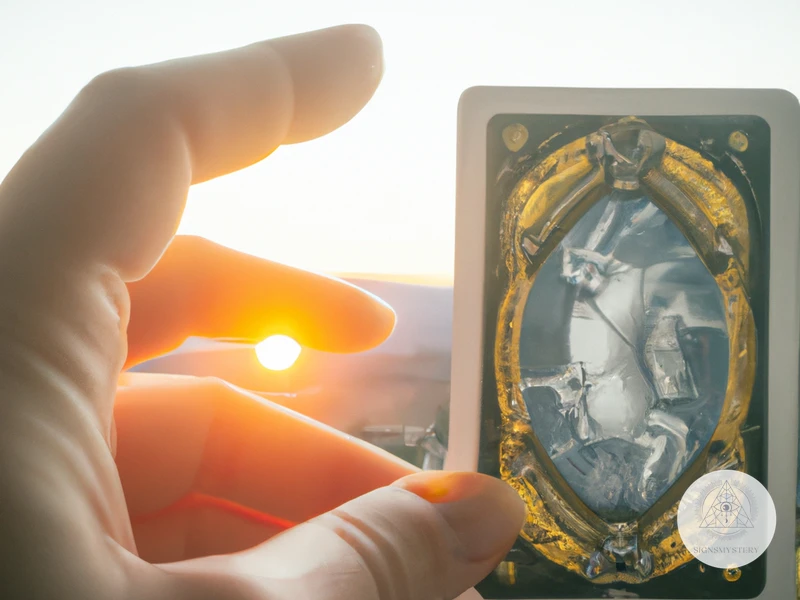
As we delve further into the history and evolution of the Rider-Waite Tarot Deck, we cannot deny the significance of its symbolism. Each image and color in the deck has a deeper meaning that reflects the human experience and the mysteries of the universe. The symbolism employed in the Rider-Waite Tarot Deck is a blend of esoteric, mythological, and religious influences that can leave a reader feeling captivated, confused, and in awe. Let us explore the intricate and fascinating symbolism of this iconic deck.
The Major Arcana
The Major Arcana of the Rider-Waite Tarot Deck consists of 22 cards, each with its own unique symbolism and significance. These cards represent the journey of the Fool, a metaphor for the journey of life.
The Fool (0) is the first card of the deck and represents new beginnings, a sense of adventure, and the start of a journey.
The Magician (I) represents manifestation, creativity, and resourcefulness. This card signifies the ability to manifest your desires and turn your ideas into reality.
The High Priestess (II) represents intuition, mystery, and hidden knowledge. This card symbolizes the hidden depths of the subconscious mind and the secrets waiting to be unlocked.
The Empress (III) represents fertility, creativity, and abundance. This card embodies the nurturing and creative qualities associated with motherhood.
The Emperor (IV) represents authority, structure, and control. This card symbolizes the masculine energy and the need for order and structure in our lives.
The Hierophant (V) represents tradition, conformity, and religion. This card signifies the need to conform to societal norms and seek guidance from organized religion.
The Lovers (VI) represent love, relationships, and harmony. This card signifies the union of two people and the choices we make in matters of the heart.
The Chariot (VII) represents willpower, determination, and victory. This card embodies the need to take control of your life and achieve your goals through hard work and determination.
Strength (VIII) represents courage, inner strength, and fortitude. This card symbolizes the ability to overcome challenges and find inner strength to face adversity.
The Hermit (IX) represents introspection, withdrawal, and solitude. This card signifies the need for introspection, taking time for yourself and withdrawing from the outside world.
The Wheel of Fortune (X) represents destiny, fate, and change. This card signifies the cyclical nature of life, the ups and downs, and the inevitability of change.
Justice (XI) represents fairness, balance, and truth. This card symbolizes the need for justice and fairness in all aspects of life.
The Hanged Man (XII) represents surrender, sacrifice, and introspection. This card signifies the need to let go of control and surrender to the natural flow of life.
Death (XIII) represents transformation, endings, and new beginnings. This card signifies the end of a cycle and the beginning of something new.
Temperance (XIV) represents balance, moderation, and harmony. This card symbolizes the need for balance in all aspects of life, finding harmony between opposing forces.
The Devil (XV) represents materialism, addiction, and temptation. This card signifies the lure of material possessions, unhealthy behaviors, and temptations that can lead to self-destruction.
The Tower (XVI) represents chaos, destruction and upheaval. This card signifies a time of crisis and upheaval, forcing us to let go of outdated beliefs and structures.
The Star (XVII) represents aspiration, hope, and inspiration. This card symbolizes the need to have hope and faith in the future, working towards our aspirations.
The Moon (XVIII) represents illusion, intuition, and the subconscious. This card signifies the need to explore the hidden depths of the subconscious mind and the illusions we create for ourselves.
The Sun (XIX) represents clarity, success, and joy. This card symbolizes success, happiness, and the light of awareness shining down on us.
Judgement (XX) represents awakening, rebirth, and new possibilities. This card symbolizes the end of a cycle and the awakening of new possibilities.
The World (XXI) represents completion, fulfillment, and harmony. This card signifies the completion of a journey and the fulfillment of our desires, finding harmony and balance in life.
Each card in the Major Arcana holds its own unique message and symbolism, offering insights and guidance on our journey through life.
The Minor Arcana
The Minor Arcana is composed of four suits, each with its own set of symbolism representing various aspects of human life. The suits are typically referred to as Wands, Cups, Swords, and Pentacles, which correspond
Subscribe to Our Newsletter
Sign up to receive the latest news and updates.
Wands: Represented by the element of Fire, Wands symbolize creativity, ambition, and growth. The imagery on the cards often features sprouting plants and trees, indicating growth, as well as people holding Wands or tools associated with work, indicating productivity.
Cups: Represented by the element of Water, Cups symbolize emotions, relationships, and intuition. The imagery on the cards often features people holding or pouring cups, indicating sharing and emotional connections.
Swords: Represented by the element of Air, Swords symbolize the mind, communication, and conflict. The imagery on the cards often features people holding or fighting with swords, indicating struggles and obstacles that require mental clarity to overcome.
Pentacles: Represented by the element of Earth, Pentacles symbolize material possessions, wealth, and practicality. The imagery on the cards often features people holding or surrounded by Pentacles, indicating a focus on tangible, earthly matters.
The Court Cards in each suit also represent specific personalities or archetypes that embody the qualities of that suit, and can indicate the influence of a particular individual or energy on a situation. The Page is often associated with youth and new beginnings, the Knight with action and movement, the Queen with nurturing and emotional depth, and the King with authority and mastery.
The Minor Arcana in the Rider-Waite Tarot Deck provide a detailed and nuanced set of symbols and meanings that can offer insight into a wide range of human experiences and situations.
The Artwork
The artwork of the Rider-Waite Tarot Deck is a crucial element that has contributed to its longevity as one of the most popular tarot decks in the world. Pamela Colman-Smith’s illustrations combined with Arthur Edward Waite’s esoteric symbolism, have created a captivating and intricate visual language that has inspired countless imitations and reinterpretations.
1. Imagery: The imagery of the Rider-Waite Tarot Deck is rich with iconography and symbolism. The Major Arcana cards are each depicted with a distinct character, often dressed in costume and surrounded by a detailed scene that reflects the card’s meaning. For example, the Fool is a carefree figure in ragged clothes, standing on the edge of a cliff with a small dog at his heels, symbolizing his lack of concern for danger. In contrast, the Death card shows a skeletal figure in armor, holding a banner with a white rose, representing the idea of transformation and renewal.
2. Color and Contrast: The use of color is also significant in the Rider-Waite Tarot Deck. The Major Arcana cards are predominantly yellow, red, and blue, which are primary colors that connote the three elements of fire, water, and air. The Minor Arcana cards use more subtle hues, but still incorporate color symbolism. The backgrounds are generally plain, which makes the scenes and figures stand out more vividly. The contrast between light and dark is also used to great effect, with shadows and highlights providing depth and dimension to the illustrations.
3. Details: One of the most remarkable aspects of the artwork in the Rider-Waite Tarot Deck is the level of detail in each card. The borders of the cards are intricately patterned, and the figures are drawn with precision and care. Objects and symbols within the images are also rendered with great attention to detail, often providing additional meaning to the cards. For example, the eight of cups shows a figure leaving a stack of cups behind and setting out on a journey. A tiny crescent moon is visible above the figure’s head, symbolizing the element of water and the theme of letting go.
The Rider-Waite Tarot Deck is an impressive work of art that continues to capture the imaginations of people all over the world. Its use of vivid imagery, color symbolism, and intricate details makes it an enduring classic for both tarot enthusiasts and lovers of art alike.
The Rider-Waite Tarot Deck Today
As the decades passed, the Rider-Waite Tarot Deck cemented its place as one of the most iconic and widely-known tarot decks in the world. Its enduring popularity can be attributed to a number of factors, including the depth and richness of its symbolism, the subtlety and artistry of its illustrations, and its influence on subsequent generations of tarot designers and enthusiasts. But with success comes scrutiny, and the Rider-Waite Tarot Deck has not been immune to controversy or criticism. Nonetheless, its impact on the world of tarot cannot be denied, and it continues to inspire and captivate those who turn to it for guidance and insight into the mysteries of life.
Popularity and Influence
The Rider-Waite Tarot deck has gained immense popularity and has been a significant influence on tarot readings and art in the modern era.
One of the factors contributing to the deck’s popularity was its accessibility. The images on the cards were simple, recognizable, and easy to interpret, making it easier for newer readers to understand and connect with the tarot.
The deck has inspired a plethora of artists and readers worldwide, leading to numerous interpretations and expansions on the original deck. This has helped maintain the deck’s relevance and popularity over time.
The Rider-Waite Tarot deck’s influence extends beyond tarot readings and into popular culture as well. The deck has appeared in movies, TV shows, books, and various other forms of media. This constant exposure has helped keep tarot and divination relevant and accessible to a broader audience.
The following table summarizes the popularity and influence of the Rider-Waite Tarot deck.
| Factors | Summary |
|---|---|
| Accessibility | The simplicity of the images made it easier for new readers to connect with the tarot. |
| Inspiration | The deck has inspired a plethora of artists and readers worldwide, leading to numerous interpretations and expansions on the original deck. |
| Popular Culture | The deck has appeared in various forms of media, keeping tarot and divination relevant and accessible to a wider audience. |
The Rider-Waite Tarot deck’s popularity and influence are a testament to its enduring relevance and appeal. Whether you are a seasoned tarot reader or just starting out, the Rider-Waite Tarot deck remains a must-have in any collection.
Imitations and Reinterpretations
The Rider-Waite Tarot Deck has undoubtedly left a lasting impact on the art of tarot, as it has inspired many imitations and reinterpretations. Some tarot creators have tried to replicate the tarot deck’s format, while others have added their unique spin.
Imitations of the Rider-Waite Tarot Deck frequently copy both the imagery and the format of the tarot deck. Many of these imitations retain the traditional 78-card format and similar imagery for each card. Some of these imitations even bear a striking resemblance to the original Rider-Waite Tarot Deck. However, many imitations lack the subtleties and profound symbolism of the Rider-Waite Tarot Deck.
On the other hand, reinterpretations of the Rider-Waite Tarot Deck incorporate the tarot’s original imagery but interpret it in new ways. These reinterpretations are usually created to cater to specific audiences, such as feminist or LGBTQ+ tarot readers. Some reinterpretations replace the traditional imagery with completely new designs, often with a modern twist.
One of the most well-known reinterpretations of the Rider-Waite Tarot Deck is the Thoth Tarot Deck, created by Aleister Crowley and Lady Frieda Harris. The Thoth Tarot Deck adds much more symbolism and nuance to the traditional cards. It incorporates mystical concepts from various spiritual traditions, including alchemy, astrology, and Kabbalah.
Another example is the Robin Wood Tarot Deck, which builds on the Rider-Waite Deck’s imagery but emphasizes nature and magic. The Robin Wood Tarot Deck incorporates natural elements such as trees and animals into each card, giving the deck an earthy and whimsical feel.
Some reinterpretations apply new themes and aesthetics to the Rider-Waite Tarot Deck. For example, the Cosmic Tarot Deck infuses the Rider-Waite images with a futuristic and intergalactic motif. Meanwhile, the Victorian Romantic Tarot Deck transports the Rider-Waite Tarot Deck to the Victorian era, drawing inspiration from the artworks of the Pre-Raphaelites.
The Rider-Waite Tarot Deck’s legacy is evident in the numerous imitations and reinterpretations that have followed it. While some of these tarot decks remain close to the Rider-Waite Tarot Deck’s original format, others take creative liberties and develop their interpretations. As new tarot readers continue to emerge, it is certain that the Rider-Waite Tarot Deck will continue to evolve and inspire new forms of tarot.
Controversies and Criticisms
The Rider-Waite Tarot Deck, like any cultural artifact, has not been immune to controversies and criticisms. Some people have taken issue with certain aspects of the deck, ranging from petty quibbles to more substantial accusations of prejudice and ignorance.
1. Lack of diversity: One of the most common criticisms aimed at the deck is its lack of diversity. The deck depicts almost exclusively white people, with very few exceptions. Some have argued that this lack of representation is a reflection of the times in which the deck was created, while others maintain that it is a more insidious form of whitewashing.
2. Gender roles: Another source of contention is the deck’s portrayal of gender roles. The traditional gender binary is reinforced in many of the cards, with men being shown in positions of power and women as passive or submissive. However, it is worth noting that some of the cards, such as the High Priestess and the Queen of Swords, challenge these traditional roles.
3. Cultural appropriation: There have been accusations of cultural appropriation leveled against the deck, particularly in relation to its use of symbols and imagery from non-Western cultures. Some argue that this appropriation is disrespectful and misrepresentative, while others defend it as a legitimate form of creative expression.
4. Simplification of symbols: Finally, some critics have taken issue with the deck’s simplification of traditional tarot symbols. The Rider-Waite deck, for example, replaces the traditional suit of coins with the more easily recognizable suit of pentacles. While this simplification may have helped make the deck more accessible to beginners, some argue that it comes at the expense of depth and complexity.
While the Rider-Waite Tarot Deck has undoubtedly had a significant impact on the world of tarot and spirituality, it is important to acknowledge and engage with its controversies and criticisms in the ongoing process of cultural and artistic analysis.
Conclusion
As we conclude this journey through the history and evolution of the Rider-Waite Tarot deck, we are left with a sense of awe and fascination at the enduring power of these cards. From their humble beginnings in medieval Italy, through their transformation in France, and their eventual rebirth under the guidance of Pamela Colman-Smith and Arthur Edward Waite, the Rider-Waite Tarot deck has become an iconic symbol of divination and spiritual insight.
Through its intricate symbolism and rich imagery, the Rider-Waite Tarot deck continues to captivate and inspire seekers of all kinds. Whether used for personal reflection, spiritual guidance, or for more practical purposes such as decision-making and problem-solving, these cards offer a unique lens through which we can explore the mysteries of the human experience.
Despite their popularity and influence, the Rider-Waite Tarot deck has not been without controversy and criticism. Some have accused the deck of promoting negative stereotypes and perpetuating harmful ideologies, while others have questioned its authenticity and criticized its historical accuracy.
Yet despite these challenges, the Rider-Waite Tarot deck remains a powerful symbol of the human experience, offering us a window into the mysteries of our own psyche and the world around us. Whether we use the cards for divination or simply as a tool for self-reflection and personal growth, the Rider-Waite Tarot deck has much to offer us in our ongoing quest for wisdom and insight.
Frequently Asked Questions
What is the difference between tarot and oracle cards?
Tarot cards have a specific structure and set of rules, while oracle cards can have any number of cards with a variety of messages and no set rules.
What does the “Rider” in Rider-Waite Tarot refer to?
The Rider is the name of the company that first published the deck in 1909.
What is the significance of the images on the Rider-Waite Tarot cards?
The images are rich in symbolism and can be interpreted in multiple ways, providing a comprehensive tool for divination and introspection.
Why is the Rider-Waite Tarot deck so popular?
The deck’s clear and detailed imagery, as well as its accessibility for beginners, have contributed to its enduring popularity.
What is the role of intuition in reading the Rider-Waite Tarot?
Intuition plays an important role in interpreting the cards and their meanings, allowing the reader to tailor the messages to their specific situation.
Can the Rider-Waite Tarot be used for self-reflection and personal growth?
Yes, the cards can provide insights into the user’s thoughts, emotions, and behaviours, and be used as a tool for personal growth and introspection.
Are there different variations of the Rider-Waite Tarot deck?
Yes, there are variations of the deck with different color schemes, sizes, and borders.
Can non-professionals learn to read the Rider-Waite Tarot?
Yes, the Rider-Waite Tarot is a popular choice for beginners due to its clear imagery and accessible interpretation.
What is the controversy surrounding tarot cards and their use in divination?
Critics argue that tarot cards lack a scientific basis and rely on vague interpretations and intuition, while supporters believe in their spiritual value and ability to provide guidance and insights.
How have modern interpretations of the Rider-Waite Tarot evolved from its original meaning?
Many modern interpretations of the deck focus on themes such as feminism, social justice, and contemporary spirituality, reflecting the changing cultural values of society.



